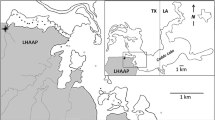Abstract
In 1998, we conducted a field-validation study of the chronic 28-day whole-sediment toxicity test with Leptocheirus plumulosus in Baltimore Harbor, MD, an area where this amphipod is indigenous. This study included an evaluation of the effect of sieving on sediment chemical concentrations and the use of field replicates, or separate grabs from the same site, which provided an estimation of within-site chemical and toxicologic variability. Six stations in Baltimore Harbor, MD, were included in this evaluation. Chemical analysis of two separate unsieved field replicates from the six sites indicated that, overall, the chemical concentrations of replicates within each site were similar, especially for metals. Organic contaminants particularly total PCBs, had the highest variability between replicates. Chemical variability did not appear to be related to differences in organic carbon content or grain size or to variability in toxicologic end points. Results supported the use of composite samples in sediment toxicity tests. In addition, in most cases, sieving had little effect on sediment chemistry. For the metals and trace elements, only selenium showed a substantial change after sieving, with some samples increasing after sieving and others decreasing. Concentrations of acid-volatile sulfide (AVS) increased 194.6% at one station after sieving, although in most other cases, AVS and simultaneously extracted metals remained relatively unchanged. As expected, concentrations of organics generally decreased after sieving, but in the majority of cases this decrease was small (i.e., coefficient of variation ≤25%). Total benzene hexachloride and total chlordanes had the greatest changes, whereas polychlorinated biphenyl concentrations decreased at only two stations after sieving. Concentrations of polyaromatic hydrocarbons showed little change after sieving. These changes in sediment chemistry due to sieving must be viewed in the larger context of the potentially confounding effects that indigenous organisms may have on the interpretation of test results from whole-sediment toxicity tests.
Similar content being viewed by others
Author information
Authors and Affiliations
Rights and permissions
About this article
Cite this article
Fisher, ., McGee, ., Wright, . et al. The Effects of Sieving and Spatial Variability of Estuarine Sediment Toxicity Samples on Sediment Chemistry. Arch Environ Contam Toxicol 47, 448–455 (2004). https://doi.org/10.1007/s00244-003-0221-3
Issue Date:
DOI: https://doi.org/10.1007/s00244-003-0221-3




